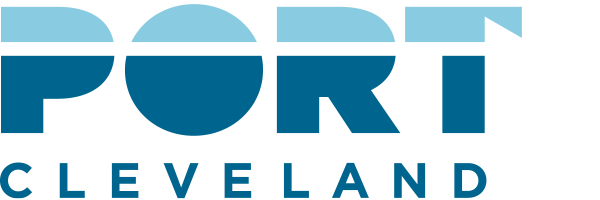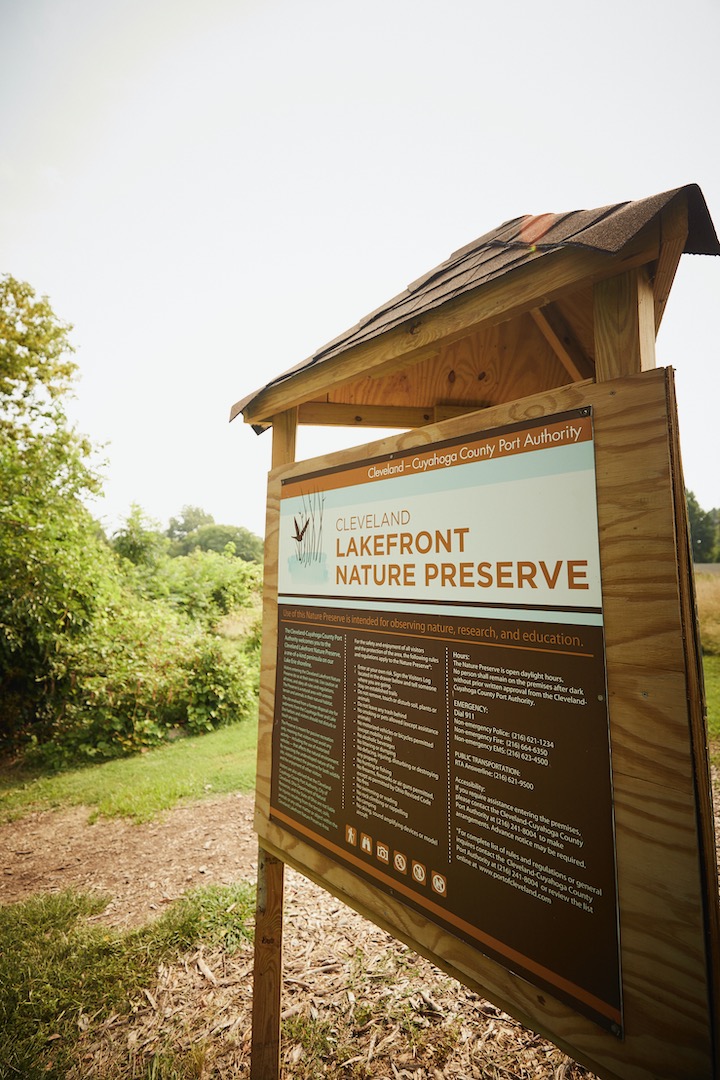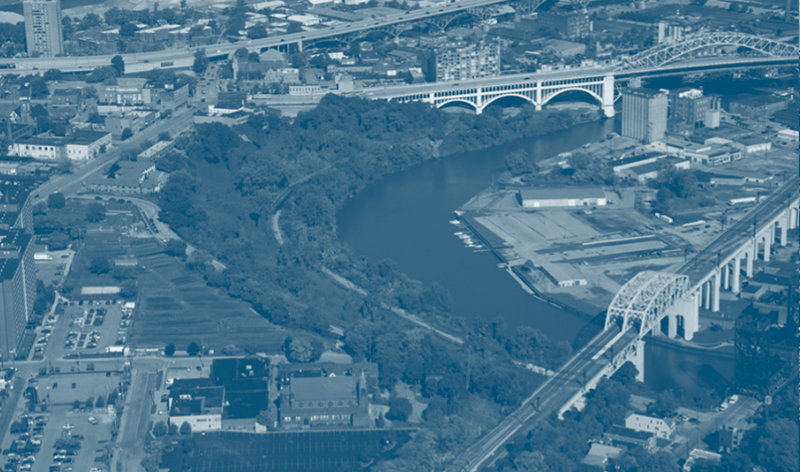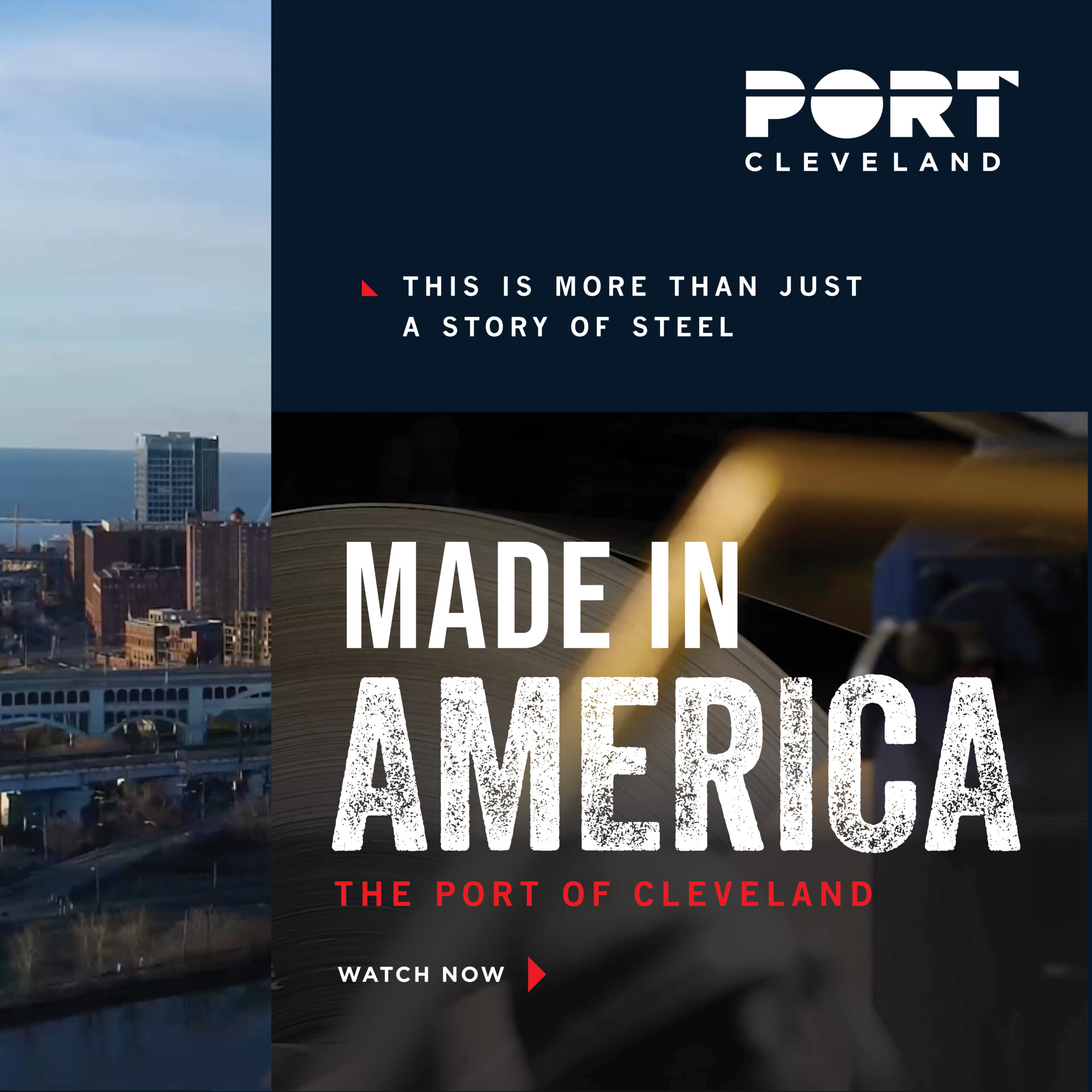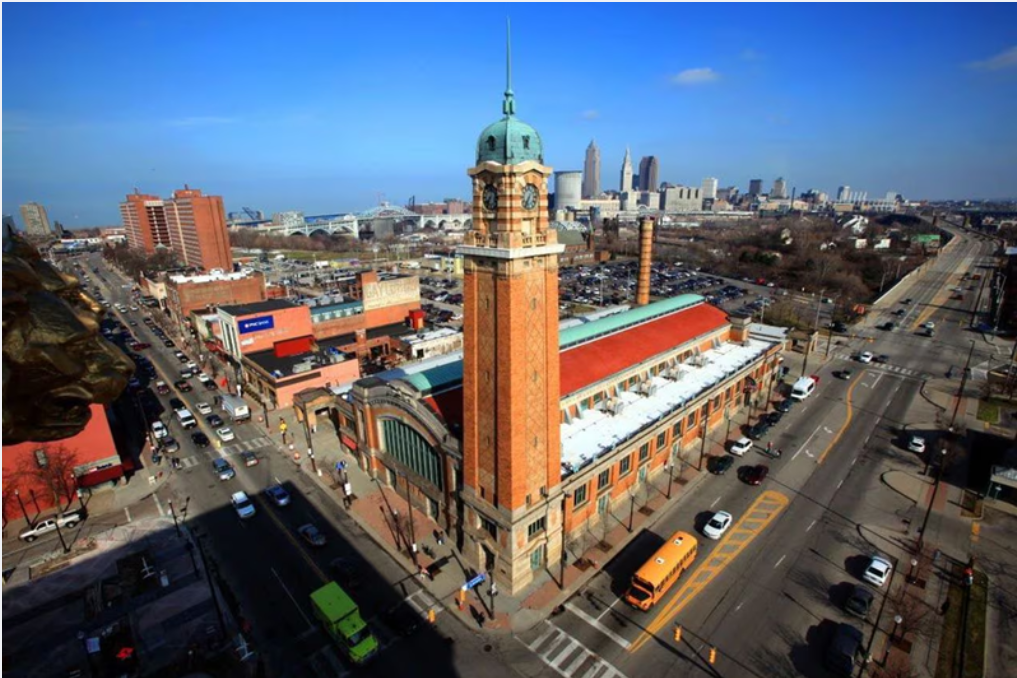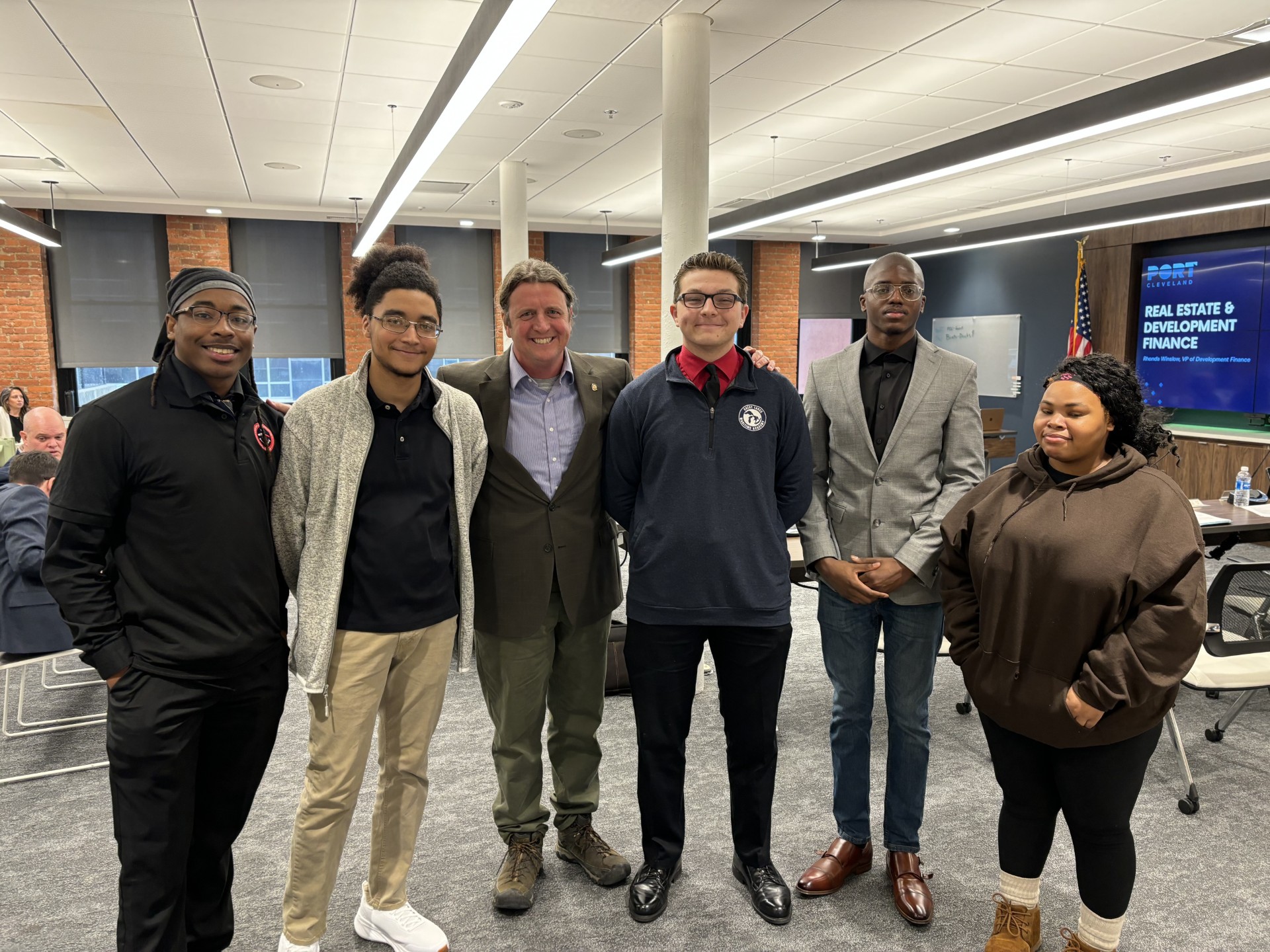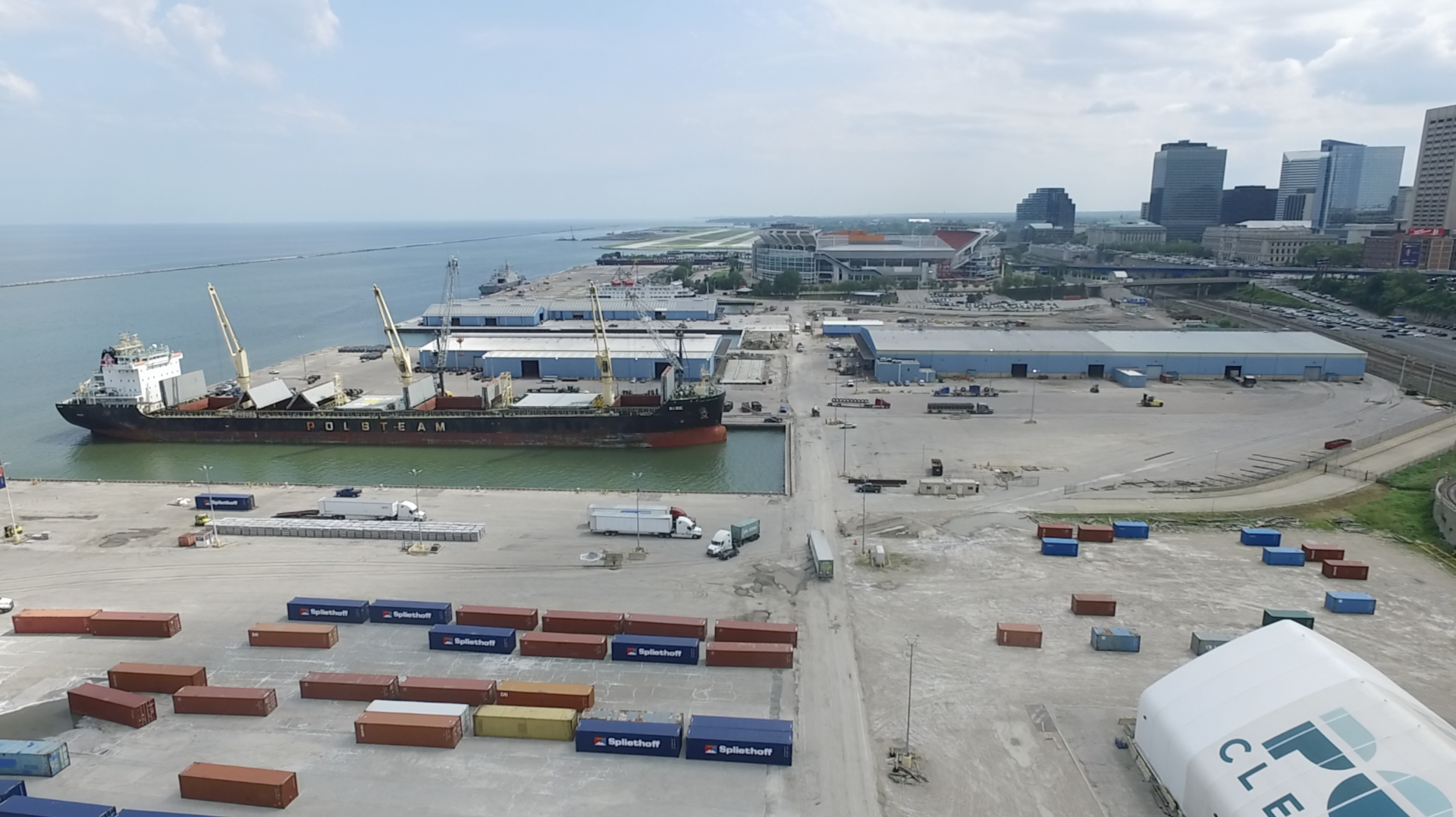Press Releases
Port of Cleveland and Ireland’s Shannon Foynes Port sign agreement to expand transatlantic trade
Port of Cleveland and Ireland’s Shannon Foynes Port sign agreement to expand transatlantic tradeStrategic pact with Ireland’s second largest port aims to strengthen maritime commerce between Great Lakes region and Europe
CLEVELAND — June 23, 2025 — The Port of Cleveland has signed a strategic agreement with Shannon Foynes Port Company (SFPC), Ireland’s second-largest port operator, to strengthen trade ties and unlock new business and economic opportunities between the Great Lakes region and Europe.
The memorandum of understanding (MOU) builds on the longstanding historical and economic connections between the U.S. and Ireland. It aims to grow transatlantic commerce, attract new investment, and offer companies on both sides of the ocean a faster, greener, and more efficient alternative to traditional coastal shipping routes.
The memorandum of understanding (MOU) is built on the strong historical ties between the Great Lakes Region and the West of Ireland. As evidenced by earlier shipping as part of the Cleveland-Europe Express, the Port of Cleveland is strategically located to provide direct access to the St. Lawrence Seaway and the Great Lakes, a $6 trillion regional economy.
“What makes this partnership especially powerful is the unique positioning of our two ports,” said David Gutheil, Interim President and CEO of the Port of Cleveland. “Together we provide access to two huge international markets that present enormous opportunity for business development. In signing this MOU, we want to explore every opportunity to strengthen that connection and drive business development on both sides of the Atlantic. We’re genuinely really excited about what’s ahead and confident in the mutually benefits this collaboration can deliver.”
Shannon Foynes is located on the Shannon Estuary, one of Europe’s deepest natural harbors and adjacent to the world’s busiest shipping lanes. The port is strategically positioned as a key cost effective and efficient European gateway for transatlantic trade.
Both ports offer cost-effective, multimodal access to major commercial and industrial markets, providing a unique value proposition to companies seeking faster, greener and more reliable alternatives to traditional coastal shipping routes. The move is very much in keeping with U.S.-Irish trade relations as it seeks to support and promote international trade between the two.
Cuyahoga County Executive Chris Ronayne said: “The partnership between the Port of Cleveland and Ireland’s Shannon Foynes Port is an exciting development for Cuyahoga County.
“The agreement will open new opportunities to grow our economy, attract investment, and enhance our global trade connections,” he continued. “By strengthening our international relationships, we’re helping local businesses reach new markets and bringing long-term economic benefits to our communities.”
Patrick Keating, Shannon Foynes’ Port CEO added; “This MOU reflects the ambition of Shannon Foynes Port. “While we provide critical access for trade to and from Ireland, we are also a key gateway into and out of Europe for transatlantic trade. That is what essentially underpins this agreement with the Port of Cleveland as we will together seek to advance the enormous, each-way trade opportunity from this global trade crossroad. We look forward to working with the Port of Cleveland, which has similar ambition and values to us, to explore the full breadth of these opportunities for the greater good of our respective organizations and communities we serve.”
About the Port of Cleveland
The Port Authority was established in 1968 with a mission which includes collaborating with government and private partners to assist private industry in retaining and creating jobs through the provision of access to waterborne transportation facilities. The Port Authority in 2014 initiated the Cleveland-Europe Express, which was and is a transformative service that reintroduced container service in the Great Lakes St. Lawrence Seaway. The Port is instrumental in promoting waterborne trade in northeast Ohio, and whose harbor moves over 13 million metric tons of global cargo annually. The Port’s local benefits include supporting over 23,000 jobs and provides an economic benefit of more than $7.0 billion.
About SFPC
Shannon Foynes Port Company (SFPC) (www.sfpc.ie) is the second largest Irish Port Operator handling in excess of eleven million tonnes of solid and liquid cargo annually through the six terminals currently operational within the Shannon Estuary. The Company is Ireland’s largest bulk port company, having a 61% share of the market. The recently launched Irish National Ports Policy defines Shannon Foynes Port Company as a Port of National Significance (Tier 1). Shannon Foynes Port Company is a Commercial Semi State Port. It has statutory jurisdiction over all marine activities on a 500km2 area on the Shannon Estuary, stretching from Kerry/Loop Heads to Limerick City.
Port of Cleveland to unveil new gate at Cleveland Lakefront Nature Preserve
Port of Cleveland to unveil new gate at Cleveland Lakefront Nature Preserve
CLEVELAND – June 19, 2025 – The Port of Cleveland is proud to announce the unveiling of a brand-new, artist-designed gate at the Cleveland Lakefront Nature Preserve (CLNP). The public is invited to join the Port and community partners for a dedication event at 11 a.m. on Monday, June 23, 2025 at the preserve, located at 8701 Lakeshore Blvd., Cleveland.
The event will take place rain or shine. The celebration will feature remarks from David Gutheil, Interim President & CEO and Chief Commercial Officer of the Port of Cleveland; Linda Sternheimer, Senior Vice President of Urban Planning and Engagement; and Steve Manka, the Cleveland-based artist behind the gate’s custom design. The new gate, designed by Manka, reflects the natural beauty, ecological diversity, and welcoming spirit of the preserve — serving as both a functional landmark and an artistic tribute to this cherished community greenspace.
In addition to the unveiling, the Port will honor Will Friedman, former President and CEO, with a special dedication recognizing his more than a decade of visionary leadership and lasting contributions to the Port and Northeast Ohio.
“We’re proud to celebrate this new addition to the Cleveland Lakefront Nature Preserve,” said David Gutheil, Interim President & CEO. “This space represents our ongoing commitment to protecting the lakefront, supporting urban greenspaces, and providing the public with access to Lake Erie’s natural beauty.” Join us as we celebrate a new chapter for this beloved public space and honor those who have helped shape its legacy.
About the Cleveland Lakefront Nature Preserve: Managed by the Port of Cleveland, the Cleveland Lakefront Nature Preserve is an 88-acre natural public space along the Lake Erie shoreline. Originally created as a confined disposal facility, the area has been carefully transformed into a thriving urban nature preserve t features three trails totaling 2.5 miles, offering visitors opportunities to hike, birdwatch, and enjoy scenic views of Lake Erie and the Cleveland skyline. The preserve supports a diverse mix of habitats , including grasslands, meadows, forests, mudflats, shrublands, and wetlands, providing critical space for migratory birds and native wildlife.
Linda Sternheimer and Steve Manka will be available for media interviews following the event.
Event Details:
What: Cleveland Lakefront Nature Preserve Gate Unveiling & Dedication
When: Monday, June 23, 2025 | 11:00 a.m.
Where: Cleveland Lakefront Nature Preserve, 8701 Lakeshore Blvd., Cleveland
Contact: Kierra Cotton, Manager of Marketing & Communications, kierra.cotton@portofcleveland.com
Port of Cleveland Approves $92 Million in Financing for Housing and Hotel Projects Fueling Regional Growth
Port of Cleveland Approves $92 Million in Financing for Housing and Hotel Projects Fueling Regional Growth
CLEVELAND – June 12, 2025 – The Port of Cleveland’s Board of Directors today approved $92 million in financing to support three major development projects: two mixed-use housing developments in Cleveland totaling 355 residential units, and a new 136-room AC Marriott hotel at the former VA hospital site in Brecksville.
Together, the projects reflect the Port’s continued role as a catalyst for community revitalization and regional economic growth. Projects approved are:
· $35 million in tax-exempt revenue bonds inducement request for the Watterson Lake Apartments, for a new mixed-use affordable housing development by Bridging the Gap Development (BTG) at West 74th Street and Detroit Avenue. The project will include 136 units ranging from studios to four-bedroom apartments, all affordable to households earning 80% or less of the area median income. Thirty units will be under CMHA project-based voucher contracts. The building will feature 9,100 square feet of retail, a playground, and community meeting space. BTG, led by emerging developer Derrick Tillman, was selected by Enterprise Community Partners as part of its Equitable Path Forward initiative. The non-binding action is needed to acquire Low Income Housing Tax Credits. Full consideration and approval will be made at a later date.
· $32 million in taxable lease revenue bonds for construction of a six-story AC Marriott Hotel at Valor Acres in Brecksville—the ambitious redevelopment of the former Veterans Administration hospital site. The $42.9 million hotel will include 136 rooms and a rooftop bar, adding a key hospitality component to the 185-acre mixed-use campus, which includes offices, housing, retail, entertainment, and parking. Construction is expected to begin in July, with completion in early 2027. The hotel is planned by DiGeronimo Development LLC and Crawford Hoying LLC.
· Up to $25 million in taxable lease revenue bonds for the redevelopment of a former county garage site into Bridgeworks, a $82.5 million mixed-use project at the west end of the Detroit-Superior Bridge in Ohio City. Led by Michael Panzica and Graham Veysey, the project includes 219 apartments, a 199-space garage, and 1,200 square feet of retail. Construction is expected to begin soon, with completion projected in the second quarter of 2027.
“These investments reflect the Port’s commitment to using creative financing tools to advance transformative projects,” said Carl Naso, Port CFO. “Whether it’s affordable housing in our neighborhoods or hotel development on a former hospital site, we’re helping move catalytic projects forward while protecting public dollars and delivering long-term value to the region.”
Fueling Growth Across Cuyahoga County
Since 1993, the Port of Cleveland has provided over $5.4 billion in financing for close to 200 projects across Cuyahoga County and beyond, playing a pivotal role in the region’s economic transformation. The Port’s financing initiatives have consistently catalyzed growth, revitalized communities, and strengthened Northeast Ohio’s economic foundation. As demand for these services continues to rise, the Port remains a driving force behind strategic development that shapes the region’s future.
Port of Cleveland Approves $8 Million in Project Management Contracts for Bulk Terminal Modernization and Emissions-Cutting Electrification Work
Port of Cleveland Approves $8 Million in Project Management Contracts for Bulk Terminal Modernization and Emissions-Cutting Electrification WorkInvestments support critical infrastructure upgrades and advance Port’s goal to become first Great Lakes port with net-zero emissions by 2050
Cleveland – June 12, 2025— The Port of Cleveland Board of Directors has approved nearly $8 million in project management contracts to support two major initiatives: modernizing the iron ore conveyance system at the Cleveland Bulk Terminal and overseeing critical infrastructure rehabilitation and electrification efforts at the Port’s general cargo dock.
A $5.2 million contract with The Ruhlin Company will provide construction management for the aging iron ore conveyor system at the Bulk Terminal. This system plays a vital role in the regional steel supply chain, moving ore from lake freighters and loading it onto smaller vessels for delivery up the Cuyahoga River to the steel mill.
The Port acquired the iron ore terminal in 1997 and since then has invested significantly in modernizing the site’s infrastructure. In 2021, the Port extended the tunnel and conveyor system to allow for taconite blending and increased throughput. However, the original segment of the system is now nearing the end of its useful life and is in need of major rehabilitation —a project expected to take at least two years, according to Dave Gutheil, interim CEO and chief commercial officer.
Modernizing Key Infrastructure and Advancing Port Electrification
The board also approved a $2.7 million agreement with Jacobs Engineering to manage a multi-phase infrastructure and electrification project that will significantly reduce emissions and improve operational efficiency. This work will help reduce carbon emissions of port operations by 40 percent and makes considerable progress towards the Port’s Climate Action Plan.
This initiative includes the rehabilitation of Warehouse A, the Port’s largest warehouse built in 1975, as well as major electrical infrastructure enhancements to support clean energy operations. The effort includes installation of rooftop solar panels, battery energy storage, microgrid technology in partnership with Cleveland Public Power, and electric equipment across port facilities. Key upgrades include:
· Ten electric forklifts and charging stations (replacing six diesel units)
· A new electric mobile harbor crane
· Two electric tugboats and associated charging infrastructure procured and installed by Great Lakes Company
· Shore power installation at Dock 24
· Rooftop solar and microgrid systems at Warehouse A
Jacobs Engineering will provide day-to-day oversight of these improvements, which are expected to be completed by December 2028.
A Climate-Driven Investment in Cleveland’s Maritime Future
The Port’s modernization efforts are supported by two major public grants: $27.2 million from the U.S. Department of Transportation’s Maritime Administration and $4.9 million from the Ohio Department of Transportation’s Maritime Assistance Program. Together, these investments are transforming the Port of Cleveland into a national model for sustainable shipping.
These infrastructure and electrification upgrades are projected to cut the Port’s carbon emissions by 40 percent—a major step toward achieving the goals outlined in the Port’s Climate Action Plan, which calls for net-zero greenhouse gas emissions by 2050. Once completed, the Port of Cleveland will be the first Great Lakes port to implement such an ambitious and comprehensive decarbonization strategy, reinforcing its leadership in climate-forward maritime innovation.
In other business, the Port of Cleveland welcomed Catherine Tompkins, Senior Counsel at KeyBank, as the newest member of its Board of Directors, appointed by County Executive Chris Ronayne and replacing Andrew Jackson. Tompkins brings extensive financial expertise and deep knowledge of credit risk management to the board. Her appointment begins Thursday, and she is expected to play an important role in guiding the Port’s ongoing infrastructure investments and long-term strategic planning.
New Documentary Spotlights the Port of Cleveland on the Unsung Heroes Powering America’s Industrial Backbone
New Documentary Spotlights the Port of Cleveland on the Unsung Heroes Powering America’s Industrial Backbone
CLEVELAND — The Port of Cleveland debuted a powerful new documentary shining a spotlight on Cleveland and the working-class heroes behind the steel that drives America. “Made in America: How the Port of Cleveland Supports the Region’s Economy” is a cinematic tribute to the people, processes and places that form the backbone of US industry.
Underscored by stunning visuals of the Great Lakes and bustling docks, the film tells the story of how raw materials flow through the Port of Cleveland and become high-strength steel that supports America’s cars, appliances, bridges and buildings.
“This one is for the masters of American craftsmanship,” opens the narrator, setting the tone for a story that honors the laborers whose hands forge the future of the nation — from miners and longshoremen to steelworkers and ship captains.
At the center of the story is the Port of Cleveland, a critical hub for transporting iron ore from the mines of the upper Great Lakes to Cleveland-Cliffs’ steel mill, where it is transformed into finished steel.
We are proud to be part of a process that is not only made in America, but made with American strength, innovation, and pride,” said David Gutheil, interim CEO of the Port. Through interviews with port officials, manufacturing leaders, and vessel line executives, the documentary sheds light on the essential — and often overlooked — supply chains that underpin U.S. manufacturing. With over 23,000 jobs tied to the Port of Cleveland and $7.07 billion in annual economic activity generated, the film makes clear the port’s local and national significance.
“Each steel coil is produced for a specific customer to ensure they get the right product at the right time in the right way,” said Chad Asgaard, General Manager, Cleveland-Cliffs, in the film.
The documentary also addresses the Port’s forward-looking environmental and technological initiatives — including new ore tunnel extensions and eco-conscious logistics — positioning it as a model of modernization and sustainability.
With stakes reaching beyond Northeast Ohio, the film touches on broader economic themes. According to a Department of Homeland Security report cited in the documentary, the closure of a single lock in Northern Michigan could plunge the nation into recession, highlighting just how vital Great Lakes shipping is to the national economy.
“This is more than a story of steel,” Gutheil said. “Made in America is a tribute to the strength, resilience, and the enduring legacy of American industry.”
CLICK HERE to watch!
Port Board approves support for $49.5 million West Side Market renovation and $44 million Superior Arts District renovation
Port Board approves support for $49.5 million West Side Market renovation and $44 million Superior Arts District renovation
CLEVELAND – March 13, 2025 – Two transformative projects — a nearly $50 million West Side Market overhaul and a $44 million Superior Arts District mixed use project — received significant support today from the Port of Cleveland board of directors.
“These projects will redo two historical properties in our city and we are proud to be able to help make both projects happen,” said J. Stefan Holmes, Port board chair. “The West Side Market is a cherished institution that attracts visitors from around the world, some of them who arrive via cruise ships using our Port. And the textile building project will bring much needed housing and retail space to a growing, vibrant neighborhood.”
Revitalizing the West Side Market
The $49.5 million West Side Market transformation will breathe new life into the 112-year-old landmark. The market’s metamorphosis involves renovation of the Market Hall, adjacent arcades and the basement. The capital lease financing approved by the Port Board allows exemption of state sales and local taxes on construction materials.
Renovations will begin this summer, starting with the East Arcade, a largely vacant produce hall between the parking lot and the main market building. Early improvements will include:
- New HVAC systems and upgraded vendor stalls.
- Basement renovations featuring mechanical upgrades, walk-in coolers, a shared commercial kitchen and a new freight elevator.
Future phases will transform the North Arcade and Courtyard into vibrant destinations with new seating areas, restaurants, event spaces, food stalls, full-service bars and public dining options.
“We have one of the most stunning market structures in the country, and this initiative is focused not only on preserving this vital historic treasure, but also supporting small businesses and having greater community impact,” said Rosemary Mudry, executive director of the Cleveland Public Market Corporation, the non-profit that manages the West Side Market for the City of Cleveland, which owns the property. “We have received tremendous support from many partners and we are immensely grateful to the Port for their assistance in making this great regional asset even better.”
“The West Side Market is a cherished institution that attracts visitors from around the world, including some who arrive via cruise ships using our Port,” said Holmes. “We’re proud to support this vital renovation, which will ensure the Market continues to thrive for generations to come.”
A New Chapter for the Superior Arts District
The Port Board also approved issuing up to $25 million in lease revenue bonds to support TurnDev’s redevelopment of the historic Heller-Keller-Kohn textile buildings at 2202 and 2230 Superior Avenue, converting them from old textile buildings into a mixed-use development. The project will include:
- 100 market-rate apartments.
- 2,261 square feet of street-level retail space.
- 108 climate-controlled parking spaces
The two former industrial buildings housed garment manufacturing operations until the later part of the 20th century. The project is across the street from the CrossCounty Mortgage headquarters, which TurnDev led. TurnDev is renovating Superior Avenue’s historic ArtCraft building into Cleveland’s new police headquarters.
—–
Since 1993, the Port of Cleveland has provided over $5.4 billion in financing for close to 200 projects across Cuyahoga County and beyond, playing a pivotal role in the region’s economic transformation. The Port’s financing initiatives have consistently catalyzed growth, revitalized communities, and strengthened Northeast Ohio’s economic foundation. As demand for these services continues to rise, the Port remains a driving force behind strategic development that shapes the region’s future.
Holmes added: “The Port is proud to support investments that create jobs, attract residents, and strengthen our neighborhoods.”
Contact: Nancy Lesic, 216.392.9634
Port of Cleveland Board Elects New Officers
Port of Cleveland Board Elects New Officers
CLEVELAND – March 13, 2025 – The Port of Cleveland’s Board of Directors today elected David Wondolowski as the new Chair of the Board, alongside J. Stefan Holmes as Vice Chair and Peggy Zone Fisher as Secretary/Fiscal Officer.
Wondolowski expressed gratitude for the opportunity to lead the Board at such an important time.
“I’m honored to take the helm of this vital organization,” said Wondolowski. “I deeply respect the trust placed in me, and I’m committed to building on the strong foundation laid by my predecessor. The Port plays a crucial role in driving economic growth and connecting our region to the world, and I look forward to working with my colleagues to advance that mission.”
The Board expressed its appreciation to outgoing Chair Holmes for his dedicated service, recognizing his steady leadership and commitment to the Board. His guidance has been instrumental in advancing key initiatives that have strengthened Cleveland’s position as a hub for commerce and development.
Port of Cleveland Off to a Strong Start in 2025 with $97 Million in Impactful Development Financing
Port of Cleveland Off to a Strong Start in 2025 with $97 Million in Impactful Development Financing
CLEVELAND – February 13, 2025 – The Port of Cleveland continues to play a critical role in advancing redevelopment projects across Northeast Ohio, today approving financing, sales tax savings, and PACE bonds to support more than $97 million in transformative projects in Cleveland and Lakewood.
The approved projects include the redevelopment of a historic Ohio City property, the transformation of a former auto dealership in Lakewood, and the construction of a new senior living and library facility on Cleveland’s west side.
Together, these projects will add more than 300 new apartments, including 51 units of affordable senior housing, along with commercial and community spaces.
With this latest action, the Port has now approved more than $850 million in financing assistance since January 2024.
The projects approved today are:
· Barry Buick Redevelopment (Lakewood) – $24.4 Million Lease Revenue Bonds The Port approved $24.4 million in lease revenue bonds to support the redevelopment of the former Barry Buick auto dealership and service center on Detroit Road. The $30.5 million project will feature two four-story mixed-use buildings with 124 apartments and 1,500 square feet of commercial space. Construction is slated to begin in Q1 2025 and finish by Q2 2026. The development is led by NewBrook Partners and The Krueger Group.
· Rauch & Lang Carriage Company (Voss Aerospace Building, Ohio City)– Capital Lease and $8 Million PACE Bond Fund Bonds
The Port is partnering with MRN Ltd subsidiaries to redevelop the historic Voss Aerospace building into Rauch & Lang Carriage Company, a $51.6 million mixed-use project. The Port will provide sales tax savings through a capital lease and issue $8 million in PACE (Property Assessed Clean Energy) bonds for energy efficiency improvements. The project will include 129 apartments, 8,000 square feet of commercial space, 5,000 square feet of retail/restaurant space, and parking for 122 vehicles.
Originally constructed in the 1870s, the building played a key role in Cleveland’s carriage and auto industries before being repurposed for materials handling. Construction is expected to begin in Q1 2025, with completion by end of year 2026. The project is led by MRN’s Jori Maron, a developer with more than 20 years of experience redeveloping historic properties in Cleveland.
· Karam Senior Living & Walz Library (Cleveland’s West Side) – $5 million in lease revenue bonds
The Port is partnering with Northwest Neighborhoods CDC and Salus Development LLC to develop the $21.2 million Karam Senior Living featuring 51 affordable senior apartments and a new branch of the Cleveland Public Library at 7918 Detroit Avenue. The Port is providing a capital lease to provide sales tax savings to the project.
Located at West 80th Street and Detroit Avenue, Karam Senior Living will include a community room, laundry facilities, on-site parking, and a wellness center. Construction is scheduled to begin in Q1 2025, with completion in Q3 2026.
Northwest Neighborhoods, a community development corporation (CDC) is the nonprofit provider of affordable housing and community development services for Cudell, Detroit Shoreway and Edgewater on Cleveland’s west side.
The CDC’s executive director, Bridget Kent Marquez, said, “The Port has been another key partner in the interconnected relationships that are ensuring success for this catalytic project.”
“The Port Authority continues to be a pivotal force in advancing redevelopment across the Cleveland region,” said J. Stefan Holmes, Port Board Chair. “We are proud to support these projects that will transform key sites, create much-needed housing, and enhance our communities.”
Since 1993, the Port of Cleveland has provided over $5.4 billion in financing for close to 200 projects across Cuyahoga County and beyond, playing a pivotal role in the region’s economic transformation. The Port’s financing initiatives have consistently catalyzed growth, revitalized communities, and strengthened Northeast Ohio’s economic foundation. As demand for these services continues to rise, the Port remains a driving force behind strategic development that shapes the region’s future.
In 2024 alone, the Port approved 20 projects totaling $753 million in development financing—making it the second-highest revenue year for development finance in its history. Notably, the Port set a new record for revenue while keeping expenses under budget, reinforcing its commitment to fiscal responsibility and high-impact investments.
Port Approves Major Grant for Marine Safety Program That Trains Cleveland High School Students
Port Approves Major Grant for Marine Safety Program That Trains Cleveland High School Students
CLEVELAND, February 13, 2025 – The Port of Cleveland has approved a $110,000 grant to Argonaut, a nonprofit organization that provides maritime and aviation career training to students at Davis Aerospace and Maritime High School in the Cleveland Metropolitan School District. This hands-on program not only prepares students for future careers in the maritime industry but also enhances critical safety operations on the Cuyahoga River and Lake Erie.
With this funding, Argonaut will continue to increase the of students in its Marine Safety Program, expanding opportunities for Cleveland high school students to gain real-world experience in maritime careers and strengthen their connection to the city’s growing waterfront economy.
The Port’s grant will allow Argonaut to:
· Expand student participation in the Marine Safety Programs
· Strengthen maritime and waterfront education and training programs
· Enhance youth workforce training opportunities in a high-demand industry
· Support ongoing safety operations for Cleveland’s recreational and commercial maritime communities
“We are committed to ensuring that economic development benefits every corner of our community,” said Carl Naso, Port CFO. “Argonaut has been a vital partner in providing hands-on workforce training while also playing a critical role in keeping our waterways safe. This grant allows them to expand their impact, providing more Cleveland students with career opportunities while bolstering safety on the Cuyahoga River and Lake Erie.”
Argonaut’s program gives students real-world experience while contributing to public safety efforts on Cleveland’s waterways. In 2023, Argonaut’s crew:
· Assisted 91 ships navigating Cleveland’s harbor
· Partnered with the U.S. Coast Guard and emergency services on 123 missions
· Led 10 active in-water rescues and assisted with 32 additional rescue operations
Additional Argonaut programs help keep Cleveland’s waterways clean. Students use specially designed tandem vessels, Flotsam and Jetsam, to remove floating debris from the Cuyahoga River and Inner Harbor. Four active Davis students and two Davis graduates manage clean-up
efforts four days a week after school and throughout the summer. They also gain hands-on experience with mechanical, fueling, safety inspections, and vessel operations.
The Port of Cleveland contracts with Argonaut to captain the vessels and work with students.
By combining education, workforce development, and public safety, Argonaut is creating a pipeline of future leaders in Cleveland’s growing waterfront economy.
“The Port’s continued investment in the future of Cleveland’s maritime workforce is invaluable,” said Drew Ferguson, Founder and CEO of Argonaut. “This funding allows us to provide students with immersive, real-world learning experiences while making Cleveland’s waterways cleaner, safer, and more accessible for everyone.”
A number of Argonaut graduates at the Port board meeting told stories about how life-changing the program has been for their career trajectories.
The Port’s Community Investment Fund —made possible by the success of the Port’s development finance program—is funded by 10% of revenues from development finance projects. This ensures that the Port’s economic development efforts create tangible benefits for historically disadvantaged communities by supporting workforce training, economic opportunity, and community improvement initiatives.
Since its launch, the Community Investment Fund has supported a range of impactful projects across Cuyahoga County. With this latest grant, the Port’s total investment in Argonaut now totals $380,000 since 2019, underscoring its long-term commitment to strengthening Cleveland’s workforce, creating educational opportunities for students, and improving quality of life for the region.
Port’s new contract with terminal operator, Logistec USA, projected to significantly increase annual operating revenues
Port’s new contract with terminal operator, Logistec USA, projected to significantly increase annual operating revenues
CLEVELAND – Dec. 12, 2024—The Port of Cleveland has approved a new contract with Logistec USA Inc. to be the terminal operator for the 2025 shipping season, a partnership expected to significantly increase operating revenues.
Logistec, a Montreal-based company with operations at 91 terminals across 62 North American port locations, has been providing terminal services at the Cleveland Bulk Terminal since 2017 and the General Cargo Terminal since 2019. These terminals are critical to the regional economy, handling essential materials like iron ore and limestone as well as various general cargo. The Port’s General Cargo Terminal handles between 350,000 and 550,000 metric tons of cargo annually.
Under the new contract, which runs from April 1, 2025, through March 31, 2026, the increase in the fixed charges and tonnage assessment annually paid to the Port by Logistec will result in significant improvements to the Port’s operating revenues.
The agreement is expected to bring in significant additional operating revenue based on a baseline of 350,000 metric tons, with Cleveland Terminal Tariff charges projected to separately generate additional operating revenue.
“This agreement is a win-win for the Port,” said David Gutheil, Chief Commercial Officer at the Port of Cleveland. “Logistec has been an exceptional partner, working with us to attract new cargo opportunities and drive growth at our terminals, an example of which were the three cranes that moved through the Port earlier this year that were destined to the Intel project near Columbus. They’ve played an instrumental role in broadening the Port’s capabilities, ensuring that our facilities are competitive and attractive to a diverse array of industries.”
Terminal operators like Logistec are the backbone of modern port operations, ensuring the efficient movement of goods through facilities that serve as gateways to the global economy. Their work involves handling diverse types of cargo, maintaining equipment and managing workforce logistics. By optimizing these operations, terminal operators enable ports like Cleveland to attract and retain shipping partners, support regional industries and drive economic growth.
Gutheil emphasized Logistec’s commitment to operational excellence and environmental sustainability, values that align closely with the Port’s strategic goals. Their extensive North American network and specialized expertise make them uniquely equipped to manage the Port’s complex and growing cargo demands.
Gutheil said the Port has a good relationship with the Logistec management team, which is expected to remain in place for the foreseeable future.
Rodney Corrigan, President of Logistec Stevedoring Inc., said, “We are proud to continue our partnership with the Port of Cleveland. Together, we are driving sustainable growth and enhancing the region’s supply chain capabilities. Cleveland is a critical hub in the Great Lakes, and we are committed to delivering exceptional service to our customers and stakeholders.”
